
DARPA recently released a broad agency announcement for the Tellus project, a 2.5-year, single-phase program which seeks to develop microbe-based sensors to monitor for existing and emerging threats, pollutants, or other changing environmental conditions.
Currently, environmental monitoring relies on distributed sensor nodes on the ground, in the water, aboard unmanned aircraft, or on orbiting satellites. Researchers want to enable more rapid development of sensors for new threats, increase spatial resolution and confidence, and reduce power and logistical burdens. Microbial sensors have previously been used successfully for the analysis of analytes such as heavy metals, organic pollutants, energetic compounds, chemical warfare agents, and gasses, with sensitivities comparable to conventional sensors. Further analytical capabilities are deemed possible, as microbes are able to detect and discriminate between several target chemicals as well as respond to distinct physical stimuli such as: ultraviolet to near-infrared light; electrical potential; low frequency ultrasound; magnetic fields; temperature changes; and RF and microwave signals.
Tellus wishes to establish: the range of chemical and physical stimuli that microbial sensors can detect; environmental conditions they can tolerate; options for biologically encoded information processing; types of output signals that can be generated; and theoretical stand-off or remote distances at which these signals could be detected.
The project will explore the rapid and modular design of microbe-based sensing systems to include: tailoring of input stimuli and output signals; biologically encoded signal processing; and response times. These microbial sensing systems must be able to transduce detected stimuli into output signals such as photons, colorimetric changes, chemicals, electric current, and mechanical actuation that are measurable by optoelectronic, photonic, imaging, and electrode receiver devices.
The classes of stimuli to be detected include chemical and physical, with emphasis on sensors that work across many different environments and conditions. DARPA states that it is particularly interested in microbial sensing systems that are able to detect stimuli and relay output signals at a distance and can operate unattended for long durations.
The microbe-based sensors should be user-friendly, compact, able to detect several threats, provide simple yes-or-no responses, and be compatible with many types of stand-off and remote sensors.
